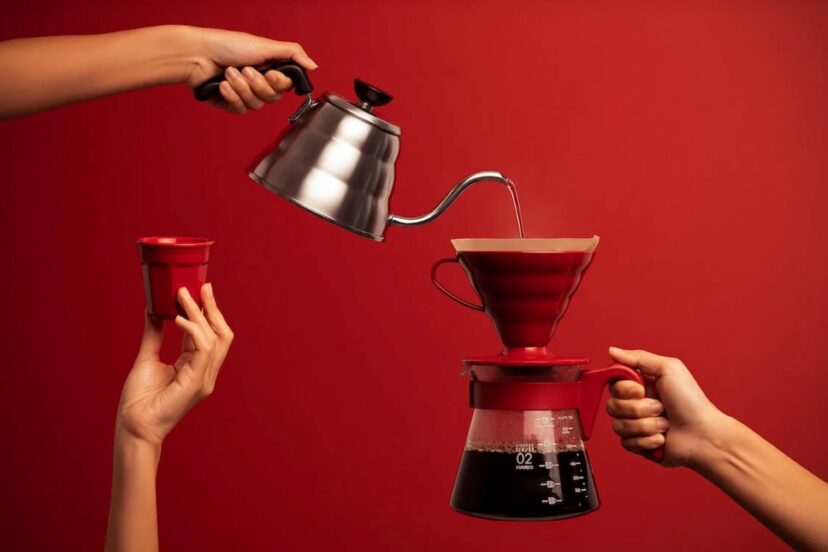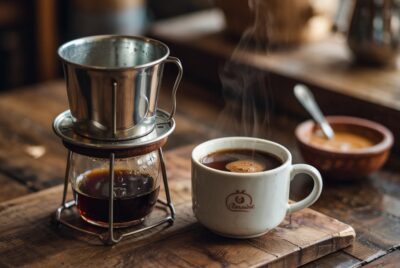How Many Tablespoons in 12 Cups of Coffee?
*We may earn a commission for purchases made using our links. Please see our disclosure to learn more.
Are you trying to brew that perfect cup of coffee at home but can’t quite nail the taste? You might be scratching your head, wondering if there’s a magic formula to it. Here’s a common puzzle: how many tablespoons should go into 12 cups of coffee? This little detail could be the key to transforming your home brew.
Did you know that most coffee aficionados use about two tablespoons per cup? That means for a full 12-cup pot, you’ll want around 24 tablespoons. But hold on, it’s not just about tossing in scoops of ground coffee; there’s an art to getting it just right. Our guide will walk you through finding your ideal coffee-to-water ratio on how many tablespoons in 12 cups of coffee and the tricks to measuring out those beans or grounds like a pro.
Whether you’re using grandma’s old drip machine or trying out the latest espresso gadget, we’ve got tips for every type of brewer. Ready for top-notch home-brewed java each morning? Keep reading!
Determining the Coffee-to-Water Ratio
Understanding the perfect coffee-to-water ratio is essential for brewing the best cup of coffee. Whether you follow SCAA standards, use the golden ratio, or adjust for personal preferences, getting the right balance is key.
SCAA standards
The Specialty Coffee Association of America (SCAA) sets guidelines for crafting a quality cup of coffee, aiming to enhance the flavor and ensure consistency. According to SCAA standards, the ideal coffee-to-water ratio falls between 1:18 and 1:16 by weight.
This means for every gram of coffee, you should use between 16 to 18 grams of water. To achieve this precision in your morning brew, especially when making 12 cups at once, adherence to these measurements is key.
Experts agree that following SCAA recommendations can significantly improve your brewing experience. For a standard cup using a common drip coffee maker or other equipment, this translates into about two tablespoons per six ounces—a guideline that aligns with general practices among seasoned baristas and home enthusiasts alike.
Always adjust based on personal taste preferences; some may prefer their drink stronger or milder than what’s suggested by professional body standards. Keep in mind grind size as well—it influences extraction and overall taste profile—ensuring you’re always close to achieving perfect harmony in each sip.
Golden ratio
The golden ratio for brewing coffee is the ideal balance of coffee to water, ensuring a flavorful and well-balanced cup. To achieve this, many experts recommend the standard 1 to 2 tablespoons of ground coffee per cup or following the Specialty Coffee Association of America’s (SCAA) guidelines.
Some experimentation may be necessary based on personal preference and desired strength, as adjusting the amount of coffee used can significantly impact the flavor profile. It is important to find a suitable ratio that suits individual tastes and brewing methods.
In addition, when perfecting your brew using different roast levels or specialty ingredients, it’s crucial to maintain an optimal coffee-to-water ratio to enhance and bring out these unique flavors.
Adjusting for personal preferences
When considering personal preferences, it is essential to adjust the coffee-to-water ratio according to individual taste. Whether you prefer a bolder flavor or a milder brew, customization allows you to tailor your coffee just the way you like it.
Experimenting with different amounts of ground coffee and water can help achieve the ideal strength and flavor profile for your perfect cup of coffee.
To cater to personal preferences, some individuals may choose to use more or less than the standard 2 tablespoons per cup measurement when brewing their coffee. Adapting this ratio will allow you to find the right balance that suits your unique taste buds.
Measuring Tools for Accurate Coffee Quantities
When it comes to measuring the perfect amount of coffee for your brew, there are several tools you can use. From traditional coffee scoops and spoons to more precise digital scales, choosing the right method can make a big difference in the flavor of your cup.
Let’s explore these options further.
Scoops and spoons
Scoops and spoons are essential tools for measuring coffee accurately. Using the right measurement method ensures consistency in your coffee brewing. Here are some tips for using scoops and spoons effectively:
- Use a standard tablespoon to measure ground coffee. A general rule is 2 tablespoons per cup, so for 12 cups of coffee, you’ll need 24 tablespoons or six ounces of coffee.
- Consider investing in a digital kitchen scale for precise measurements if you prefer grams over tablespoons.
- When using a coffee pot, the recommended amount of coffee scoops for 12 cups is typically between 12-18 depending on personal preference for strength.
- Adjust the amount of ground coffee based on the grind size to achieve the desired flavor and strength of the brew.
- For a standard 12-cup coffeemaker, aim to use about 12-13 scoops of ground coffee or approximately 24-26 tablespoons.
- Experiment with different scoop sizes and spoon types to find what works best for your personal brewing preferences.
Digital scales
When transitioning from measuring coffee with scoops and spoons to ensuring precise measurements, digital scales play a crucial role. Digital scales provide accurate readings in grams, ensuring consistency in every brew.
By using a digital scale, you can measure the exact amount of ground coffee needed for your preferred brewing method, whether it’s drip coffee makers, French press, espresso machines, cold brew, or pour over.
This precision allows you to achieve the perfect coffee-to-water ratio and experiment with different roast levels and specialty ingredients more effectively. Additionally, digital scales offer ease of use and help avoid any guesswork when measuring the right amount of ground coffee for brewing.
Exploring Different Brewing Methods
Discover the various ways to brew your coffee, from drip coffee makers to espresso machines and cold brew methods. Each method offers a unique flavor profile, so experiment with different techniques to find your perfect cup of coffee.
Drip coffee makers
Drip coffee makers are one of the most popular brewing methods. They provide a convenient way to make multiple cups at once. To ensure the perfect ratio for your drip coffee maker, consider these factors:
- Use 2 tablespoons of ground coffee per cup of water. For 12 cups of coffee, this would mean using 24 tablespoons or about six ounces of coffee.
- Adjust the amount of coffee based on desired strength. Experiment with different ratios to find the flavor you prefer.
- Consider the grind size of your coffee beans, as it affects extraction. If using a coarser grind, you may need to increase the amount of coffee used.
- Keep in mind that a standard 12-cup coffee maker typically requires around 12-13 scoops or 24-26 tablespoons of ground coffee.
- Measuring in grams is also an option, with a recommended range of 115 to 150 grams for brewing 12 cups.
French press
To make coffee using a French press, follow these steps:
- Measure out 2 tablespoons of coffee per cup of water.
- Coarsely grind the coffee beans to ensure optimal extraction.
- Add the ground coffee to the French press.
- Pour hot water over the grounds, ensuring they are fully saturated.
- Stir the mixture gently to ensure even saturation.
- Place the lid on the French press with the plunger pulled all the way up to help trap heat during brewing.
- Allow the coffee to steep for 4 minutes before pressing down on the plunger slowly and evenly.
- Pour and enjoy your flavorful French press coffee.
Espresso machines
Espresso machines are favored for their ability to produce a strong, concentrated coffee. They work by forcing hot water through finely-ground coffee beans under high pressure. This creates a small, intense shot of coffee known as an espresso. When using an espresso machine to brew 12 cups of coffee, you’ll need approximately 180 to 240 grams of ground coffee or about 36 to 48 tablespoons, depending on your preferred strength and flavor profile.
- Utilize finely – ground coffee beans suitable for espresso machines to ensure the best extraction and flavor.
- Measure the precise amount of ground coffee with a digital scale for optimal results.
- Adjust the grind size and coffee-to-water ratio to achieve your preferred intensity and taste.
- Experiment with different brewing techniques such as adjusting the tamp pressure and water temperature for a personalized cup of espresso.
Cold brew
Transitioning from espresso machines to cold brew, the cold brew method involves steeping coffee grounds in cold water for an extended period, typically 12-24 hours. This slow extraction process results in a smooth, low-acidic coffee concentrate that can be diluted with water or milk. Here are some key points about cold brew:
- Cold brew requires a higher coffee-to-water ratio due to the prolonged brewing time, typically using 1 cup of coarsely ground coffee to 4 cups of water.
- The coarse grind size is essential for cold brew as it prevents over-extraction during the extended steeping process, resulting in a rich and mellow flavor.
- The brewing vessel for cold brew can vary from mason jars to specialized cold brew coffee makers and pitchers, allowing for convenient straining and storage.
- Once brewed, the cold brew concentrate can be refrigerated for up to two weeks, offering a convenient and ready-to-drink option for a refreshing caffeine boost.
- Cold brew is versatile and can be enjoyed over ice, blended with milk or creamer for a creamy texture, or used as a base for crafting creative coffee beverages.
Pour over
To achieve the perfect pour-over coffee, follow these steps:
- Grind your coffee beans to a medium – coarse consistency for optimal extraction and flavor.
- Heat the water to around 200 degrees Fahrenheit and rinse the paper filter with hot water.
- Add the ground coffee to the rinsed filter, ensuring an even bed of grounds for consistent extraction.
- Begin by pouring a small amount of water over the grounds to allow them to bloom, releasing carbon dioxide for better flavor.
- Slowly pour the remaining water in a circular motion, ensuring all the grounds are saturated and allowing them to drip into your serving vessel.
Taking Your Coffee to the Next Level
Utilizing different roast levels, experimenting with specialty ingredients, and incorporating customer testimonials will help you take your coffee to the next level.
Using different roast levels
Different roast levels can greatly impact the flavor profile of your coffee. Here are some ways to use different roast levels to enhance your coffee experience:
- Light Roast: Light roasts offer a bright and acidic flavor profile with higher caffeine content. They are perfect for those who enjoy a more delicate and nuanced cup of coffee.
- Medium Roast: This roast level strikes a balance between acidity and body, offering a well-rounded flavor with slightly lower caffeine content than light roasts.
- Dark Roast: Dark roasts boast a bold and rich flavor with lower acidity and higher body, making them ideal for those who prefer a stronger and full-bodied cup of coffee.
- Blending Roast Levels: Experimenting with blending different roast levels can create a unique and complex flavor profile that combines the best characteristics of each roast, enhancing the overall taste of your coffee.
- Adjusting Coffee-to-Water Ratio: It’s important to adjust the amount of coffee used based on the roast level to achieve the desired strength and flavor, as darker roasts may require slightly less coffee compared to lighter roasts due to their more intense flavors.
- Customizing Brewing Methods: Tailoring brewing methods such as pour over or French press to match specific roasts can further enhance and highlight their unique flavors, resulting in a more satisfying coffee experience.
Experimenting with specialty ingredients
Elevate the flavor profile of your brew by adding a touch of vanilla, hazelnut, or caramel syrup for a hint of sweetness and depth. Additionally, consider incorporating cinnamon, nutmeg, or cardamom to infuse aromatic notes into your coffee. Experimenting with specialty ingredients is a fun way to customize and elevate the taste of your favorite brews. This allows you to create unique and personalized coffee recipes that cater to your individual preferences.
Conclusion
In conclusion, mastering the coffee-to-water ratio is essential for brewing the perfect cup of coffee. By following these simple guidelines and using practical measuring tools, you can easily achieve the ideal balance for your preferred brew strength.
Implementing these strategies will lead to significant improvements in the flavor and quality of your coffee, ensuring a satisfying experience every time. For further exploration, consider experimenting with various brewing methods and roast levels to elevate your coffee game.
Take charge of your morning routine and savor every sip with confidence!
FAQs
Q1. How do you measure the perfect coffee ratio for 12 cups?
To get the perfect coffee ratio, use a standard measurement of about 1 to 2 tablespoons of ground coffee per cup of water.
Q2. What’s the recommended amount of coffee grounds for brewing 12 cups?
For brewing 12 cups, you’ll need between 12 and 24 tablespoons of coffee grounds, depending on how strong you like your coffee.
Q3. Can I use the same measurements in any standard coffee maker?
Yes, these measurements work with most standard coffee makers. Always check your specific machine’s guidelines just to be sure.
Q4. Are there different brewing techniques that require different measurements?
Different brewing methods might need slight adjustments in measurements, but as a general rule, start with our suggested ratio and then tweak to taste.
Q5. Why is it important to measure out your grounds when making lots of coffee?
Measuring out your ground Coffee ensures consistently flavored brews every time and helps maintain that perfect balance between the Coffee to water in every cup.




